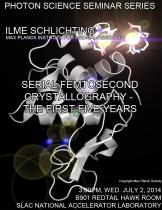Speaker: Ilme Schlichting, Max Planck Institute for Medical Research
Program Description
Protein crystallography using synchrotron radiation sources has tremendous impact on biology, having yielded structures of thousands of proteins that provide detailed insight into their working mechanisms. However, the technique is limited by the requirement for macroscopic crystals, which can be difficult to obtain, as well as by the often severe radiation damage caused in diffraction experiments, in particular when using tiny crystals. XFEL-based serial femtosecond crystallography (SFX) promises to circumvent both issues. Since the first experiments in 2009 at the LCLS, SFX has been established as a useful tool for the analysis of microcrystals, allowing monitoring room-temperature conformational ensembles providing crucial insight into catalysis, ligand binding, and allosteric regulation.





